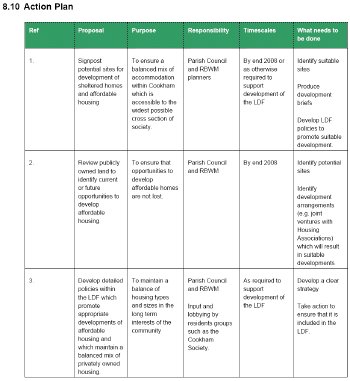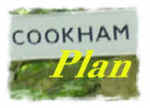
The Cookham Plan
Findings and Recommendations
Housing and Development Group
8. HOUSING DEMAND AND AFFORDABILITY
| MAIN REPORT INDEX | HOUSING DEMAND INDEX |
8 HOUSING DEMAND AND AFFORDABILITY
8.1 Remit
Review demand for housing, its affordability and options to assist young people and essential workers to live in Cookham.
8.2 Issues and Concerns
The price of housing (particularly for young people) was raised as an issue by many people during the consultation undertaken during preparation of the plan.
The main issues raised are summarised below:
-
House prices are very high.
-
Young, first time buyers cannot afford to live in the villages of Cookham. This makes it difficult for young people to find homes close to their families.
-
There is little new building so demand is high for what becomes available and pressure is created to build wherever possible.
-
Housing Association stock is dwindling due to occupants buying their homes.
-
Land and house prices are high so that Housing Associations have great difficulty in competing with the private developers. This means there is little or no increase in the availability of affordable housing.
-
A perception that there is an increase in the number of ‘buy to let’ properties which could change the balance of the community.
-
With the increase in ‘buy to let’ there is a worry that more flats will be built which are not characteristic of the village.
8.3 Housing Stock
According to the 2001 Census, Cookham Parish has 2,368 dwellings:
• 36% are detached,
• 49% semi-detached / terraced and
• 15% are flats or temporary structures (e.g. mobile homes).
80% of the dwellings are owner occupied and the rest rented: 9% by the public sector and 11% private rentals. The proportion of owner occupation is significantly higher than the averages in the rest of the borough, the South East region and England as a whole (73%, 74% and 69% respectively). Tenure data from the 2001 Census suggests that Cookham is underprovided with rented accommodation (20% of dwellings are rented) compared with the borough (27%), the South East region (26%) and all of England (31%). Of the rented accommodation available a significantly greater proportion is provided by the private sector compared to the regional and national averages (54% compared with 46% and 38% respectively). This appears to confirm people’s perceptions about the growth of the buy to let sector in Cookham.
8.4 Housing Supply
One of the central functions of the Borough’s Local Plan is to ensure an adequate and continuous supply of land for housing development in accordance with the requirements of the Structure Plan (and, going forward, the Strategic
Plan). However the scale and location of new housing development must be consistent with the Green Belt and other environmental objectives of the Plan.
The final housing allocation for the borough has not yet been published but is believed to be between 4,100 and 5,620 new dwellings by the year 2026 (273 to 281 new dwellings per annum) - Core Strategy Policy CS15 will set the proposed level. The council believes housing supply is currently meeting the strategic housing requirement. The council intends to produce Area Action Plans for its main settlements but whether this includes Cookham is unclear and should be followed up.
Policy CS16 details the approach to housing delivery which emphasizes that development should be located on previously developed land in the main borough settlements and land excluded from the Green Belt. However it also
states that dwellings should be developed at a scale and density appropriate to the surrounding area and certain criteria should be applied to ensure adequate capacity exits to create sustainable communities.
8.5 Private Sector House Prices and Demand
A study of Land Registry details for the last 6 years for SL6 9xx shows that house prices in this area have increased strongly in recent years and that the prices in Cookham are higher than the borough average.
Figure 8-1 shows the annual average change in house prices, which includes all house types – detached, semi-detached, terraced and flat/maisonette.
Figure 8-1 Overall Average House Prices and Sales
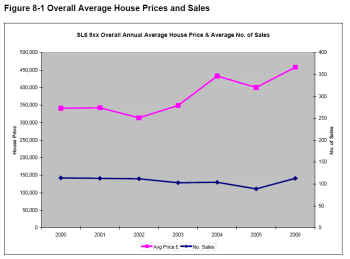
Figure 8-2 shows the differences between Cookham and the borough house prices in 2006. With all house types, Cookham prices are significantly higher than in the rest of the borough (by approximately 23% overall).
Figure 8-2 Comparison of average house prices between RBWM and Cookham
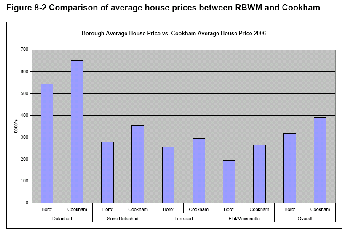
This high price of housing will make it difficult for young, first time buyers and many others to live in Cookham.
Figures for the private rental market, taken from the local estate agents show the following average rentals per month:
1 bedroom £750
2 bedrooms £950
3 bedrooms £1,100
4 or more bedrooms £4,500
Again, this level of cost is likely to restrict access to the Cookham market to those with higher incomes.
8.6 Affordable Housing
As described above, Cookham is very expensive to live in and this creates problems for public sector workers and others with lower incomes. Affordable housing is designed to meet the needs of this section of society and is housing
which is provided for rent or part sale with some form of subsidy.
As far as we have been able to ascertain, Maidenhead and District Housing Association (MDHA) is the only public sector company owning housing in Cookham. They have properties in Cookham Rise and Cookham Dean – most of these are in Cookham Rise around the Whiteladyes Lane area.
The properties include:
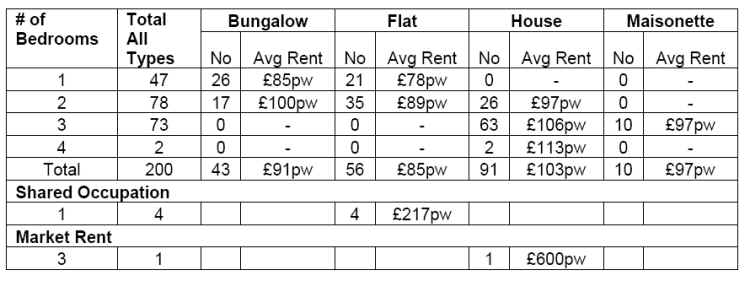
According to MDHA, there is currently a moderate demand for affordable housing in Cookham. The demand is thought to be on a similar scale to that for housing association houses in Holyport which, like Cookham, is a similar distance away from Maidenhead town centre. Furze Platt on the other hand, which is within walking distance of the town centre has roughly twice the demand of Cookham. However Cookham does have a higher demand than more outlying rural areas e.g. Waltham St Lawrence or Knowl Hill. (It should be noted that demand relates to people from across the whole Royal Borough, not those with existing connections to Cookham).
8.7 Allocation of Affordable Housing
If a person wants to move back to Cookham after study or training they have to apply for a social housing tenancy by signing on to the ‘open list’ or the ‘transfer list’. Anybody who doesn’t have an existing tenancy agreement can sign onto the MDHA open list. However this list is extremely long since it is open to almost anyone and therefore not a very realistic option for getting a tenancy.
The transfer list is only open to current tenants of MDHA and Windsor HA which would imply that it is not that easy to move counties and still get a social housing tenancy.
Strict criteria apply to placement on the statutory register. The applicant needs to have lived or worked in the borough for 6 months i.e. have a local connection.
There are currently no priorities awarded to local residents of one particular area over those from a different area within the borough. In the future, some form of prioritisation for those with local family ties would be of benefit to
maintaining the community.
A breakdown of the current waiting list numbers can be seen below:
Figure 8-4 Current Waiting Lists for Affordable Housing
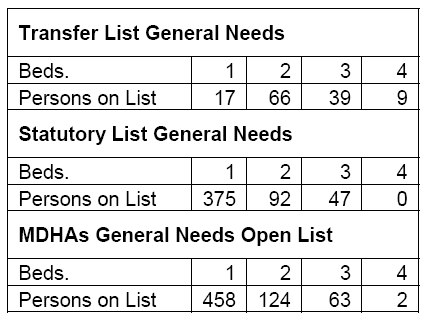
8.8 Future Policy on Affordable Housing
The need for affordable housing is recognised by RBWM in the draft Core Strategy. Policy CS 18 – Affordable housing states that:
Such housing will be sought and secured from housing developments of appropriate size and suitability, having regard to the need to provide a mix and diversity of residential development in the borough and the economics of provision. This policy will apply to sites and buildings capable of providing 5 or more units. The expected minimum level of provision will be 40%. Lower levels of provision would only be considered if the scheme was not economically
viable.
Cookham Parish is a designated ‘rural’ area and so may also be affected by Policy CS 19 – Rural Exceptions Affordable housing which states that:
In exceptional circumstances, limited affordable housing development will be permitted within or on the edge of Recognised Settlements within the Green Belt provided:
-
It can be demonstrated that all the dwellings meet a proven local need for
The site does not intrude into open countryside and is not essential to the
The scheme is limited to a small group of dwellings that can be provided in a
There is adequate access to local services and facilities by walking, cycling
The occupation of the dwellings is controlled to ensure the benefits of the
In implementing this policy the council say that they will ensure that the LDF’s proposals for the conservation and protection of the environment are not compromised. In order to protect the Green Belt the council must be satisfied
that the need for affordable housing cannot be met elsewhere including other urban settlements within a reasonable distance.
So what does this mean for Cookham? On the one hand, there is a clear need for additional affordable, public sector owned housing to bring provision up towards regional averages and to maintain the social mix and continuity of the
village. On the other there is limited space for additional development and it is important to maintain the Green Belt and other aspects of the village environment. In the future we would like to see development kept within the existing village boundaries but with greater emphasis put on affordable housing through the planning system. Mechanisms to achieve this need to be identified during development of the LDF.
8.9 Key Findings
-
The nature of the housing market is such that there will probably always be strong demand for property in attractive and well located areas such as Cookham leading to premium prices. It is beyond the scope of the Cookham Plan to be able to ensure that everyone who wants to live in Cookham is able to do so. It is therefore important to ensure that there is a balance of house sizes and public / private ownership to ensure that we maintain a balanced community. Public consultation revealed a desire for young people to be able to establish new households close to their parents.
-
The stock of public sector affordable housing in Cookham is low.
-
MDHA are having difficulty competing with private developers for land with such high land prices in the area.
-
The LDF aims to ensure that any future developments of more than 5 dwellings in the area will include a proportion of affordable houses.
-
Despite the lack of affordable housing, new development should not be permitted on the Green Belt around Cookham.
-
RBWM should be encouraged to promote the building of more affordable housing through imaginative use of the planning system. Development of the LDF presents an opportunity to formulate new policies.
-
Similarly, planning policy should be developed to:
� Manage the redevelopment of existing smaller homes into larger, more expensive units,
� Ensure that there is not excessive development of buy to let properties (especially flats).
-
Any publicly owned land which becomes surplus to requirements should be considered for affordable housing in precedence to other uses and, if so developed, local people should be given priority for such accommodation.
8.10 Action Plan
click on chart for larger image
